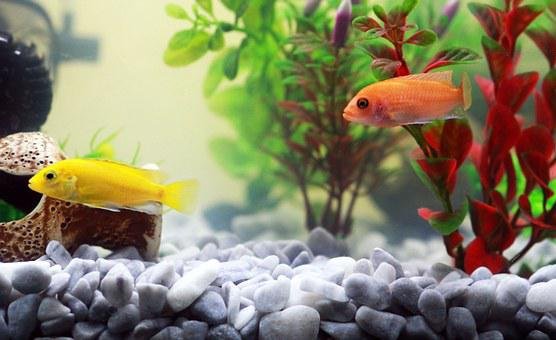Entertainment
Caring for German Blue Rams: A Comprehensive Guide
German Blue Rams (Microgeophagus ramirezi) are a popular choice among freshwater aquarium enthusiasts due to their stunning colors and peaceful nature. These small cichlids, native to the warm waters of South America, are known for their vibrant blue and yellow hues, making them a beautiful addition to any aquarium. In this blog, we will explore the essentials of caring for German Blue Rams, including tank setup, diet, behavior, and health considerations.
Introduction to German Blue Rams
German Blue Rams are small, colorful fish that typically grow to about 2-3 inches in length. They are known for their brilliant blue and yellow coloration, with males often displaying more intense colors than females. These fish are generally peaceful and can coexist with other non-aggressive species, making them an excellent choice for community tanks. However, they can be somewhat sensitive to water conditions, requiring stable and well-maintained environments.
Tank Size and Setup
Creating the right environment for German Blue Ram is crucial for their well-being. They thrive in a tank that mimics their natural habitat, which is typically warm, slow-moving waters with plenty of vegetation.
- Tank Size: A minimum of 20 gallons is recommended for a pair of German Blue Rams. For larger groups or community tanks, a larger tank is advisable to provide enough space and reduce stress.
- Substrate and Decor: Use a soft, sandy substrate that allows for natural foraging behavior. Decorate the tank with live plants, rocks, and driftwood to create hiding spots and territories. Plants like Amazon swords, java ferns, and anubias are great choices.
- Water Parameters: German Blue Rams prefer water temperatures between 78-85°F (25-29°C), with a pH range of 6.0-7.5 and a hardness of 5-12 dGH. Maintain high water quality with efficient filtration and regular water changes of 20-25% weekly.
- Lighting and Flow: Provide moderate lighting and a gentle water flow to simulate their natural environment. Too much light or strong currents can stress these fish.
Diet and Feeding
German Blue Rams are omnivores, meaning they eat both plant and animal matter. Providing a varied diet is essential for their health and vibrant colors.
- Staple Foods: High-quality cichlid pellets and flakes should form the core of their diet. These foods are nutritionally balanced and designed to meet the needs of cichlids.
- Supplemental Foods: Offer live or frozen foods such as brine shrimp, bloodworms, and daphnia. These foods are rich in protein and mimic their natural diet.
- Vegetables: Occasionally provide blanched vegetables like spinach or zucchini for added nutrients.
- Feeding Frequency: Feed small amounts 2-3 times a day. Only provide as much food as they can consume in a few minutes to prevent overfeeding and maintain water quality.
Behavior and Compatibility
German Blue Rams are generally peaceful and can be kept with other non-aggressive fish. However, they can exhibit territorial behavior, especially during breeding periods.
- Social Behavior: These fish are social and do well in pairs or small groups. However, males can be territorial, particularly during breeding. Providing plenty of hiding spots and establishing territories can help reduce aggression.
- Tankmates: Suitable tankmates include tetras, rasboras, Corydoras catfish, and other small, peaceful fish. Avoid keeping them with larger, aggressive species that may bully or stress them.
- Breeding Behavior: During breeding, males may become more aggressive in defending their territory. It’s essential to provide a stress-free environment with plenty of hiding spots for the female.
Health and Disease Prevention
Maintaining good water quality and providing a balanced diet are key to preventing diseases in German Blue Rams.
- Common Diseases: German Blue Rams are prone to diseases like Ich (white spot disease), fin rot, and parasitic infections. Symptoms include white spots, frayed fins, and unusual behavior.
- Preventive Measures: Regular water changes, proper filtration, and maintaining stable water parameters are crucial. Quarantine new fish before adding them to the tank to prevent the spread of diseases.
- Monitoring and Treatment: Regularly observe your fish for signs of illness. If disease occurs, isolate the affected fish and treat them with appropriate medications. Always follow the manufacturer’s instructions and consider consulting a specialist if needed.
Breeding German Blue Rams
Breeding German Blue Rams can be a rewarding experience, but it requires careful preparation and attention to detail.
- Breeding Setup: Use a separate breeding tank or create a designated area in the main tank. Include flat stones or broad leaves for egg-laying. Maintain a water temperature of around 82-84°F (28-29°C) to encourage spawning.
- Breeding Behavior: Males will court females by displaying vibrant colors and engaging in mating dances. After the female lays eggs, both parents will guard the nest. Eggs typically hatch in 2-3 days, and parents may move the fry to different locations for protection.
- Fry Care: Feed the fry with fine foods like infusoria or baby brine shrimp. As they grow, gradually introduce finely crushed flakes or pellets. The parents will continue to protect the fry until they are ready to fend for themselves.
Conclusion
German Blue Rams are a beautiful and rewarding species to keep in freshwater aquariums. Their stunning colors, peaceful nature, and interesting behaviors make them a favorite among hobbyists. However, they do require a well-maintained environment with stable water conditions and a balanced diet. By providing the right care, you can ensure that your German Blue Rams thrive and display their full potential. Whether you’re a beginner or an experienced aquarist, these charming cichlids are sure to bring joy and color to your aquarium.















